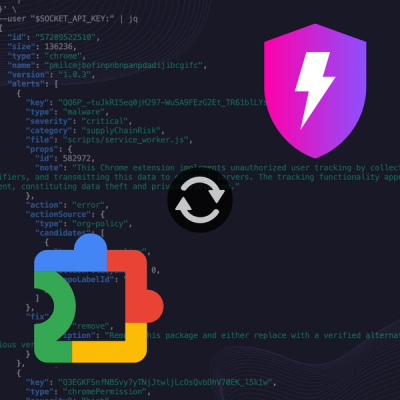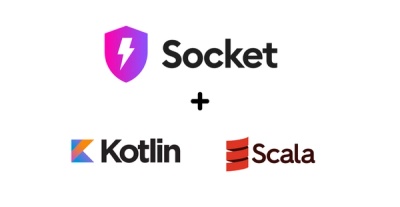
Product
Socket Now Protects the Chrome Extension Ecosystem
Socket is launching experimental protection for Chrome extensions, scanning for malware and risky permissions to prevent silent supply chain attacks.
github.com/greggman/virtual-webgl
Virtualizes a single WebGL context into multiple contexts
A demo of some WebGL apps running with only 1 shared WebGL context
and using alpha: false, premultipliedAlpha: false, preserveDrawingBuffer: true
and some other things. A similar demo for WebGL2.
And, one for a mix of WebGL1 and WebGL2.
A demo of creating and disposing of webgl contexts.
WebGL implementations often delete the oldest context when too many are created. Using virtual-webgl you can
solve this issue. Note you are still responsible for freeing all WebGL resources used by the context. All buffers,
textures, renderbuffers, framebuffers, shaders, and programs. On top of that when you're done with the context
call context.dispose() which gives virtual-webgl a chance to free its internal stuff as well.
A demo of post processing a Unity app from outside Unity. Compare to the original without post processing.
A demo displaying mapbox-gl results on a cube.
Browsers usually limit WebGL to 8 to 16 contexts max. This is one idea to overcome that limit.
If you're in control of your code then there are arguably better solutions like this for raw webgl and this for three.js (both if which I wrote BTW 😛)
I mostly wrote this for a fun short technical challenge. I have no plans to actually use it or maintain it. If you find a problem feel free to file an issue but I can't promise I can spend anytime addressing it. Pull requests are more welcome or just fork it.
Since underneath there is really only one context from the POV of the app you can do things like
const gl1 = document.createElement("canvas").getContext("webgl");
const gl2 = document.createElement("canvas").getContext("webgl");
const tex1 = gl1.createTexture();
gl2.bindTexture(gl1.TEXTURE_2D, tex1); // this would normally fail
With normal WebGL contexts you can't use resources from one context in another context but with virtual contexts you can.
This is actually probably the best use-case. You can write 2 different libraries independently of each other using WebGL and have them share resources and they won't have to worry about stepping on each other's WebGL state. An example might be, you have a video conferencing library and you want to add an effects library.
For example use a mapbox-gl-js map inside a three.js app.
I suppose you can already do this by just copying the canvas of the first app into the second but that copy is probably slow where as just rendering to a texture is fast.
See the mapbox-gl demo. It creates it's own compositor.
Include it on your page before other scripts
<script src="virtual-webgl.js"></script>
or for WebGL2 use
<script src="virtual-webgl2.js"></script>
The compositor is the part of virtual-webgl that's responsible for updating the individual canvas. The default compositor draws the framebuffer representing the drawingbuffer of that canvas, into an offscreen canvas and then calls canvas 2D's drawImage to get the WebGL results into the canvas. You can change this to do something else by providing your own compositor.
A full solution would probably require some other method but ... If you look in unity-example/index2.html you'll see code that creates a custom compositor that draws a different result than the default compositor.
The idea for the createCompositor function is that you probably need different
compositors for each canvas on the page so it's up to you how to do that. For
example you could check the canvas passed in and its ID or some data
attribute and do create different compositors for different canvases. If you
return nothing/undefined the default compositor will be created for that canvas.
As another example, if you wanted to draw a MapGL texture inside THREE.js then you'd probably make the one compositor do nothing except record the texture needed to use inside three.js. For three's canvas you'd use the default compositor. see this. I was not sure how to use an external WebGL texture in THREE.js so the example uses twgl.
Note: If a compositor has a dispose method it will be called if context.dispose is called
to give your custom compositor a chance to clean up.
In WebGL2 you must end queries and transformFeedback before exiting the current event. The good things is, AFAIK, pretty much all WebGL2 apps that use queries and/or transformFeedback already do this so it should't be a problem. But, not finishing those before exiting the event is not technically against the spec.
WebGL1 is emulated on WebGL2 in virtual-webgl2.js
When using virtual-webgl2.js WebGL2 functions are not available on virtual WebGL1 contexts but WebGL2 constants can be passed to WebGL1 contexts.
In other words:
webgl1Ctx.texImage3D(...); // error! no such function
webgl1Ctx.bindTexture(webgl1ctx.TEXTURE_3D, tex); // error! TEXTURE_3D is not defined
webgl1Ctx.bindTexture(webgl2ctx.TEXTURE_3D, tex); // ok
This should arguably not a come up. A WebGL1 context would be using WebGL1 constants. I only point this out to say virtual-webgl doesn't force WebGL1 compliance.
WebGL1 on WebGL2 support is limited
I took a quick stab at trying to emulate WebGL1 on WebGL2 so that
you could mix WebGL1 and WebGL2 in the same WebGL2 context.
That includes extensions like OES_vertex_array_object, OES_texture_float,
and ANGLE_instanced_arrays.
Unfortunately, when I got to WEBGL_draw_buffers I realized that
emulating that would require a full GLSL parser and re-writer to
change GLSL ES 1.0 to GLSL ES 3.0 and several complex transformations.
That's the long way of saying WebGL1 emulation on WebGL2 is incomplete.
There are no checks for errors.
WebGL (and OpenGL) use a asynchronous command buffer error system which means checking for errors really slows things down so this Virtual WebGL also doesn't check for errors. Your code should not be generating errors in the first place so if it is fix your code!
Where this might come up? I forget the details of the spec but,
lets say you make an invalid program. When you call gl.useProgram
it will fail and leave the previous program still the current program.
so if you call gl.uniformXXX you'll be setting the uniforms for
the previous current program. With one WebGL app that was your own
previous current program. With multiple WebGL apps that could be
some other app's current program.
That's just one example. Lots of apps don't setup textures correctly at the beginning, start loading images, start rendering, get errors, those errors stop when the image finally downloads. Those kinds of errors could bleed from one context to another.
So, run your apps without virtual-webgl and make sure they get no errors. Then after try running them with virtual-webgl and they should hopefully still get no errors.
The WebGL2 wrapper (virtual-webgl2.js) is newer and saves state so it's pretty fast. The WebGL1 wrapper (virtual-webgl.js) is older and queries state so it's pretty slow.
You could probably get even more perf by changing all the functions that set GL state to just save the state but not actually set it and then just set the dirty state at draw time. And further, for all the functions that query state just return the saved state instead of asking WebGL. That would actually probably a speedup for many poorly written apps that query things they shouldn't.
Another perf issue is you can't render directly to different canvases so I have
to make each of the canvases use a Canvas2DRenderingContext and call
drawImage. That could be solved maybe with OffscreenCanvas and
ImageBitmapRenderingContext but those features haven't shipped without a flag
as of 2018-06-05.
It could also be solved using the techniques used in this sample
Basically, put the canvas of the shared GL context full window size in the background and instead of compositing by copying to a 2D canvas, composite by setting the viewport/scissor and render to the shared GL context's canvas. The limitation of course is that the result won't appear in front of other elements but usually that's ok.
That should be trivial to implement using a custom compositor. The first time
you get a compositor put the canvas of the shared context (the one that gets
passed to composite) in the page and then render the texture being composited
using gl.viewport and gl.scissor
If your canvases are not all on screen you could try using an augmented requestAnimationFrame that only calls the requestAnimationFrame callback to draw the canvases that are on screen.
virtual-webgl adds a dispose method to the virtual contexts letting you free
the virtual context. As it is it leaves it up to the app to free all of its own
GPU resources. dispose only disposes of internal resources.
It probably would not be that hard to track resources by context and free them on dispose. It's not 100% clear that's the right thing to do always. For example since virtual-webgl lets you share resources across contexts it would be a perfectly valid use-case to create a temporary context just to create some resources and the dispose of that context but keep the created resources around.
It's perfectly reasonable to do this yourself 100% outside virtual-webgl. You just either augment the context.
Example
const buffers = new Set();
gl.createBuffer = function(oldFn) {
return function() {
const b = oldFn.call(this);
buffers.set(b);
return b;
}
}(gl.createBuffer);
gl.deleteBuffer = function(oldFn) {
return function(b) {
buffers.delete(b);
oldFn.call(this, b);
}
}(gl.deleteBuffer);
gl.dispose = function(oldFn) {
[...buffers].forEach(b) {
this.deleteBuffer(b);
});
if (oldFn) {
oldFn();
}
}(gl.dispose);
You'd need to do the same for textures, renderbuffers, framebuffers, VAOs, programs, shaders
Or you just make helper functions and make your app call those functions that does the same tracking instead of calling functions directly on the context. In other words.
const buffer = customFunctionThatCreatesABufferAndTracksIt(gl);
instead of
const buffer = gl.createBuffer();
MIT (see top of js file)
FAQs
Unknown package
Did you know?

Socket for GitHub automatically highlights issues in each pull request and monitors the health of all your open source dependencies. Discover the contents of your packages and block harmful activity before you install or update your dependencies.

Product
Socket is launching experimental protection for Chrome extensions, scanning for malware and risky permissions to prevent silent supply chain attacks.

Product
Add secure dependency scanning to Claude Desktop with Socket MCP, a one-click extension that keeps your coding conversations safe from malicious packages.

Product
Socket now supports Scala and Kotlin, bringing AI-powered threat detection to JVM projects with easy manifest generation and fast, accurate scans.